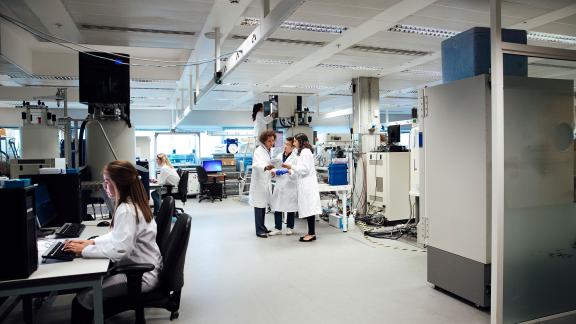Workforce redesign

Workforce redesign is about seeking new ways of working for your existing staff, to develop and broaden their current skills, build resilience and gain confidence; meeting the needs of new organisational systems and processes to improve patient care.
Importantly, when changes occur staff should feel supported and be engaged in the process of your organisational transformation. Workforce redesign can be used to help your workforce adapt.
Workforce redesign and the 10 Year Health Plan
The 10 Year Health Plan for England promotes a reinvention of the NHS through three radical shifts; hospital to community, analogue to digital, and sickness to prevention. Creating a workforce model to align with these shifts is integral to achieving these ambitions. Collaborating with your integrated care board, service providers, regional teams, NHS England, and higher education institutions and further education colleges is a crucial element in moving forward.
System-wide strategies may already be in place, or currently be in development, to support workforce redesign across health and care organisations. As part of the 10 Year Health Plan for England, £5 million has been allocated across ten integrated care systems (ICSs) to help 1,000 young people and those from deprived backgrounds into pre-employment training, entry level roles or training posts. The government has also committed to expanding apprenticeships and accessible training so that people can earn while they learn.
Below are examples for NHS organisations to consider when developing their workforce design strategies for the future.
Examples of workforce redesign
Designing new roles for current staff based on their skill sets.
Introducing new roles to tackle challenges such as staff shortages and extended waiting times.
Developing new programmes and models to allow staff to work in other areas of expertise.
Increasing opportunities for current staff to broaden skills such as through apprenticeships.
Benefits of workforce redesign
Implementing workforce redesign effectively and ensuring staff are part of the process can create significant benefits for staff, teams, patients and the organisation. These benefits include:
- enhanced patient care and experience
- improvements in staff retention
- Attracting talent
- increased staff motivation and recognition, as staff feel part of the transformation
- increased trust and efficient working within teams
- empowered, more confident and skilled staff
- increased staff satisfaction and morale, through development opportunities
- increase in effective system working for organisations.
Supporting staff through change
To help support staff through the change process, the following should be considered:
- What is the rationale behind the proposed workforce redesign? Colleagues who understand the ‘why’ are more likely to support change.
- Staff consultation - there may be ideas and potential pitfalls that have not been considered. Co-creation of workforce redesign projects can ensure high levels of acceptance and support quicker implementation.
- Provide chances for review and feedback even after the new roles or developmental opportunities have been introduced. It is possible that there are unintended consequences. Actively seeking feedback may also ensure that staff feel engaged and involved.
- Ensure managers are kept informed of how a project is developing. Staff members are likely to go to their line manager as the first point of contact should they have concerns.
- Manage organisational change with compassion. Read our page about how leading managers are supporting their staff through challenging times.
Understand how individuals adapt to change
Not all colleagues will adapt to change at the same rate. There will be those who have different approaches to change and your communications plan and support offer may need to flex depending on their attitudes. Individuals can be broadly grouped into the following types:
- Innovators – those at the forefront of change, they enjoy change and the possibilities it brings. They will be happy to support with problem solving and aiding in promoting change within an organisation.
- Early adopters – these individuals will embrace change and be happy to adapt to any new changes.
- Early majority – prefer that change implemented at a steady pace, and that changes should be agreed by everyone prior to implementation. Once everyone agrees, they are happy with proposed changes.
- Later majority – would prefer to know that a change will be successful prior to implementation, will be more likely to find issue with proposed changes.
- Late/non adopters - individuals who prefer to maintain the status quo and will find change difficult
Career progression
It is important that any workforce redesign project focuses on career progression from the start. Staff will be curious to understand how the changes may impact their careers, and what opportunities and pathways will open to them. If a new role is introduced the business may need to recruit externally to fill vacancies, but there should also be consideration of how current staff can develop into these positions.
Role of anchor organisations
Workforce redesign initiatives should consider how widening access and participation will be encouraged when implementing change. Most health and care organisations are anchor organisations in their local area so focus should be given to how the local population are impacted by the changes. This could include using the opportunity to create a talent pipeline bringing individuals into the organisation from the local area, or to consult with the local population as to what benefits they would want from any change. NHS Employers have a widening participation hub that has guidance on considerations that could be made.
Workforce redesign methodologies
Resources
We have compiled some resources below to support you in planning and executing new ideas for your workforce redesign.
- The roles explorer (login required), hosted on the Future NHS platform is a collection of resources to support the planning and delivering of workforce redesigns. It aims to support with introducing new roles, or innovative adaptations to existing roles already being deployed within a service or system. It provides information on the capabilities, training requirements and career frameworks for different roles, enabling workforce planners to choose the best fit for their service model. It also contains best practice planning methods and case studies which illustrate how roles are being deployed across different system priorities.
- NHS England’s multidisciplinary team (MDT) toolkit provides a comprehensive guide on building and developing effective multidisciplinary teams across a broad range of professional groups and system structures. It is designed to be relevant in any setting, to any objective and to progress a ‘one workforce’ approach.
- Skills for Care’s principles of workforce redesign can help organisations who are undergoing any form of organisational restructure or transformation to set out the key things that need to be taken into account when changing the way your staff work, to ensure they play a role in change.
- The Supporting integration through new roles and working across boundaries report, commissioned by NHS Employers and the Local Government Association, looks at evidence on new roles and ways of bridging organisational workforce boundaries to deliver integrated health and social care.
Workforce redesign
The NHS is exploring new ways of developing the skills of existing staff in order to meet the ever-changing needs of the service and to improve patient care.
Watch our workforce redesign webinar below, where Derbyshire Community Health Services NHS Foundation Trust, London Ambulance Service NHS Trust, and North Tees and Hartlepool NHS Foundation Trust share good practice, discuss the topic of workforce redesign, and explain how they are doing things differently.



